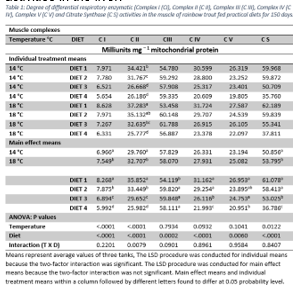EFFECTS OF PLANT-DERIVED AQUAFEED AND TEMPERATURE ON GROWTH, NUTRIENT UTILIZATION EFFICIENCIES, AND MITOCHONDRIAL FUNCTION IN RAINBOW TROUT Oncorhynchus mykiss
Rainbow trout (Oncorhynchus mykiss ) are the most widely farmed trout in the world. Rainbow trout are carnivorous cold-water species that thrive in water temperatures ranging from 13°C to 18°C. T he major challenges trout farmers currently face are expensive dietary protein and lipid sources; and rising global temperature.
A 4x2 factorial experiment was conducted to evaluate the effects of two dietary protein sources (fish meal and plant-based protein), two dietary lipid sources (100% camelina oil and a mixture of 50% fish meal and 50% camelina oil), and two water temperature regimens (14°C and 18° C) on the growth performance, nutrient utilization efficiencies, whole-body proximate composition, and mitochondrial enzyme complex activities in rainbow trout (Oncorhynchus mykiss) over a 150-day rearing period. Juvenile rainbow trout (average weight ± SD, 40 g ± 1.0 g) were randomly assigned to 24 glass aquaria (152 L) with 13 fish per aquaria. The 24 aquaria were randomly assigned to eight treatments with three replicates per treatment. The fish were fed to satiation twice daily for the entire duration of the experiment. Morphometric and quantitative measurements were taken every 30 days. Tissue was extracted from fish at the end of the experiment. The experimental results indicate that growth performance parameters such as feed efficiency (FE), and feed intake (FI) were significantly affected by diet (P<0.05). Whole-body proximate composition was not significantly affected by temperature (P>0.05) except for ash which was significantly affected (P<0.05). Nutrient utilization efficiency parameters such as protein efficiency ratio (PER), lipid efficiency ratio (LER), and protein productive value (PPV) were all significantly affected by diet (P<0.05). The results show that temperature had a significant main effect on complexes I, II, IV, V and citrate synthase in the intestine; complexes I, II, and citrate synthase activities in the muscle; and complexes I, II, and III activities in the liver (P<0.05). Diet had a significant main effect on complexes I, II, IV, V, and citrate synthase activities in the intestine; complexes I, II, III, IV, V, and citrate synthase activity in the muscle; and complexes I, II, IV, V, and citrate synthase activities in the liver. Temperature x diet interaction had significant interactive effects on citrate synthase activity in the intestine, complex II activity in the muscle, and complexes I and II activities in the liver.
